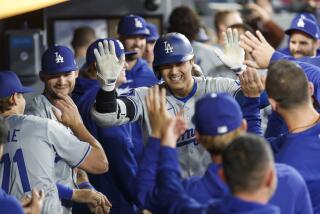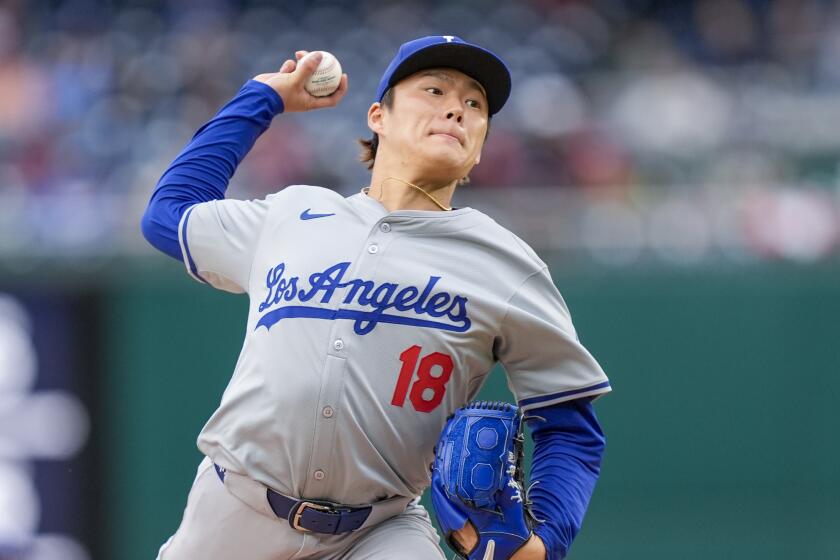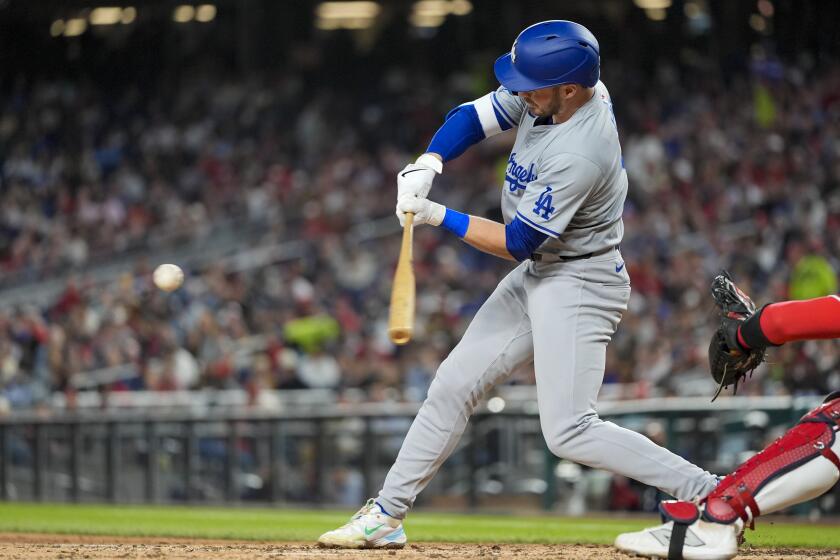Royal, loyal Blue
In the most memorable line in one of the most memorable of baseball songs, he was third.
Willie, Mickey and the Duke.
On most lists of the greatest Dodgers in franchise history, he is also third.
Jackie, Sandy and the Duke.
After his death by natural causes Sunday at age 84, shouldn’t it finally be time for Duke Snider to stand alone?
“He played every day, he did the job he was supposed to do, and did it better than anyone,” said former Dodgers teammate Don Newcombe. “That’s enough, isn’t it?”
It was more than enough, Snider quietly carving a legacy as perhaps the greatest Dodgers position player ever, one of the team’s greatest ambassadors, and a star who helped carry the team from Brooklyn to Los Angeles.
The Hall of Fame center fielder’s accomplishments might not fit neatly into a song, but they are indelibly etched into a Dodgers culture that he was still actively nurturing as recently as two winters ago.
The team was holding a rookie seminar at Dodger Stadium, and Snider, although ailing and confined to a wheelchair, traveled from San Diego to talk to the kids.
“You have to learn to hate Halloween,” he told the wide-eyed youngsters.
One of them had the nerve to ask why.
“Giants colors,” he said.
Even though Snider spent his retirement in San Diego County, he was always happy to hang out at Chavez Ravine, his presence an important symbol of those days when the players really did play for the name on the front of their shirt.
“You cannot underestimate the impact Duke Snider has had on Dodger history, from Brooklyn to Los Angeles,” said Dodgers historian Mark Langill. “He is one of the links that will live forever.”
Snider probably will forever lead the franchise in home runs (389), RBIs (1,271) and extra-base hits (814), yet one of his greatest achievements was simply being in the lineup for the opening of Dodger Stadium in 1962.
Driving to the ballpark that day, the tailpipe on his car fell off. He pulled over, picked it up, and promptly burned his hand. Worried that manager Walter Alston would bench him, he played that day with a batting glove covering the burned hand.
Snider is also known for hitting four homers in the World Series twice, including leading Brooklyn to its 1955 championship, yet he would openly scoff at those who would laud his simple ability to put a bat on a baseball.
One of the more popular photos lining the walls of Dodger Stadium is a shot of Snider swinging, but every time he walked past the photo, Duke would flinch.
“He would look at it, shake his head, and say, ‘That was a foul ball,’ ” Langill recalled.
Growing up in Compton, Edwin Donald Snider was nicknamed “Duke” by his father because he strutted around as a child, but he acted like anything but royalty.
When playing for Brooklyn from 1947 to 1957, he was considered only the third-best center fielder in New York behind Willie Mays and Mickey Mantle, yet he never complained. Coming to Los Angeles with the Dodgers in 1958, his left-handed hitting stroke was handicapped by the distant right-field fence at the Coliseum, 440 feet from home plate, but he was never bitter.
He should have been most valuable player in 1955 but lost in a close race with teammate Roy Campanella after a voter inadvertently left Snider’s name off the ballot. Even when he was inducted into the Hall of Fame, it was a struggle, with voters electing him in his 11th year of eligibility.
“Yet hanging around him, he always was the nicest, most unassuming of stars,” Langill said. “He was always truly just happy to be a Dodger.”
When the Dodgers retired his number in Los Angeles in 1980, the guest of honor was more impressed with the honored guests.
“Whenever we talked about that ceremony, all he could talk about was how Kareem Abdul-Jabbar asked for his autograph,” Langill said. “He was always amazed that people considered him something special.”
In 1995, Snider pleaded guilty to federal tax charges for not claiming money from autograph shows, and was sentenced to two years’ probation and fined $5,000, but he kept coming to Dodger Stadium and never stopped supporting the franchise to which he felt eternally indebted.
Snider’s Hall of Fame speech in 1980, which was barely nine minutes long, was more revealingly powerful than any Snider swing.
He talked about how his wife, Beverly, loved Ted Williams. He introduced his family. He mentioned his high school coaches. He lauded his parents.
He told stories about his teammates. He thanked the folks who drove down from Montreal, where Snider was a broadcaster. He pretty much talked about everyone but himself.
“It’s a little tough even getting up here,” Snider said at the end of the speech. “I’d like to thank God for including me in his master plan . . . being a Brooklyn Dodger and Los Angeles Dodger.”
The baseball bond between the two cities is stretched even thinner today, one more link broken, one more landmark gone. The Dodgers will sorely miss the quietest Duke, the littlest prince, sometimes buried in history, but always second to none.
--
twitter.com/billplaschke
--
BEGIN TEXT OF INFOBOX
Duke Snider dies at 84
The career numbers of Hall of Fame outfielder Duke Snider and his ranking on various Brooklyn/Los Angeles Dodgers all-time lists.
Snider died Sunday of natural causes at age 84. Story, AA1
SNIDER’S CAREER STATISTICS
*--* Yrs. AB R H 2B 3B HR RBI SB AVG. OBP. SLG. 18 7,161 1,259 2,116 358 85 407 1,333 99 295 380 540 *--*
WHERE SNIDER RANKS ON THE DODGERS’ ALL-TIME LISTS
*--* Games At-Bats Runs Hits RBIs 1,923 (7) 6,640 (7) 1,199 (3) 1,995 (4) 1,271 (1) *--*
*--* Doubles Triples Home Runs Walks Strikeouts 343 (2) 82 (6) 389 (1) 893 (4) 1,123 (1) *--*
More to Read
Are you a true-blue fan?
Get our Dodgers Dugout newsletter for insights, news and much more.
You may occasionally receive promotional content from the Los Angeles Times.







